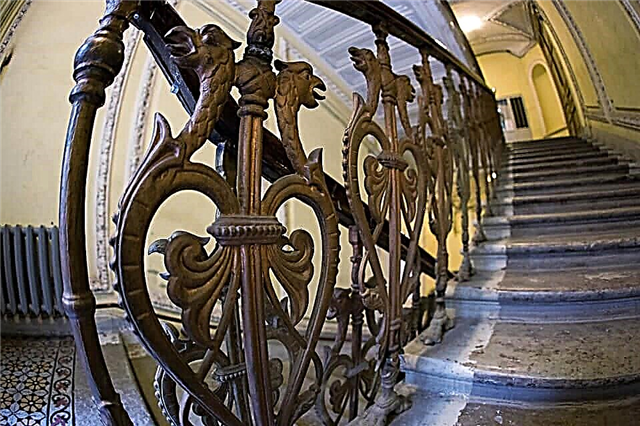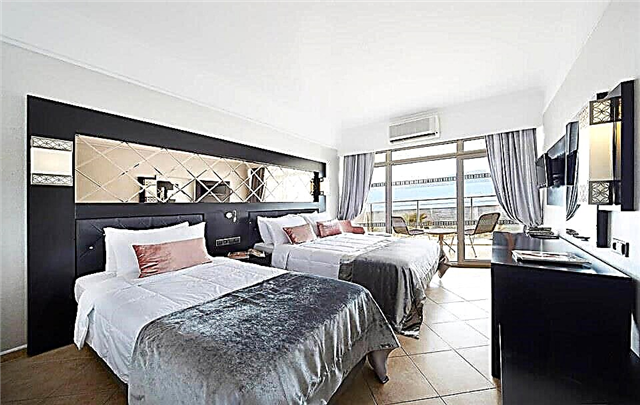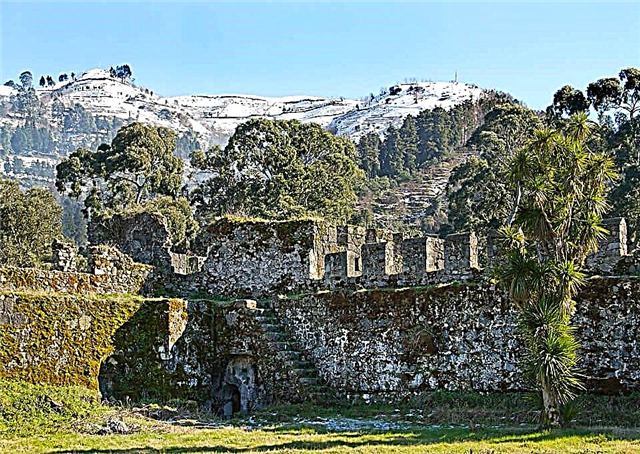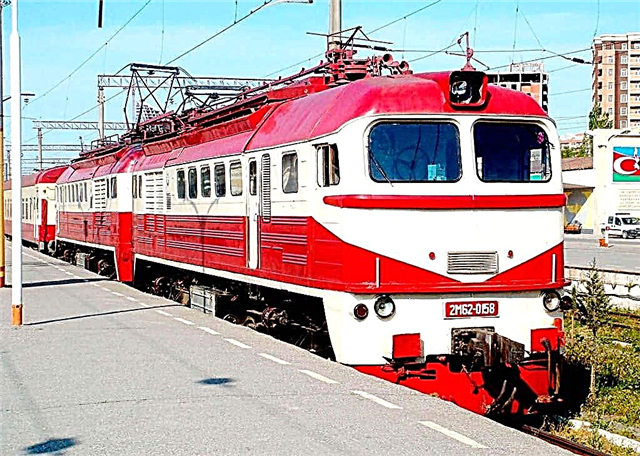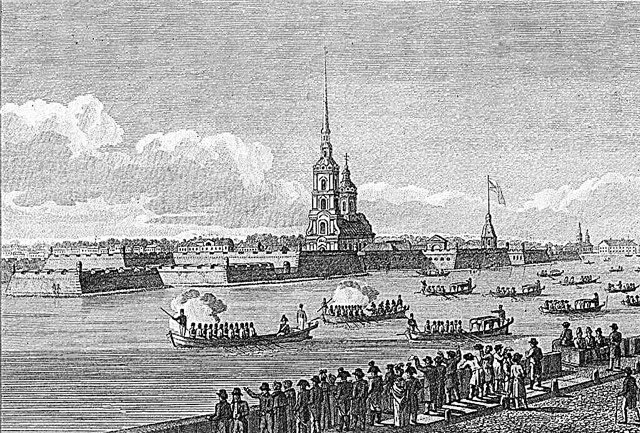The Peter and Paul Fortress in St. Petersburg is an outstanding architectural and historical ensemble of the 18th-19th centuries. Its construction marked the beginning of the founding of a new Northern capital, designed to become a political, military and economic center, change the fate of Russia, tear it away from the "hated Moscow antiquity" and bring it closer to Europe.
Construction history

The exact date of the beginning of the construction of the fortress is reliably known - May 16, 1703. It was intended for the defense of the primordially Russian Neva and Baltic territories reclaimed from the Swedes. Tsar Peter I personally chose the site for the construction and very carefully considered all the options, giving priority to the military-strategic location. The choice fell on the Hare Island, as the Finnish tribes who once lived here called it. Located at the mouth of the Neva, it is surrounded on three sides by water, all the branches of the river could be seen from it.
Together with the talented military engineer J. Lambert, the tsar drew up a plan. The construction was supervised by the architect D. Trezzini. A lot of people were driven to work: peasants, convicts, artisans, soldiers. Working conditions were inhumanly difficult. People lived in damp dugouts, ate poorly, got sick and died in thousands. Despite this, the fortress was erected in record time: in October it was ready. Its appearance resembled an elongated hexagon, which followed the contours of the island and occupied it entirely.
The structure consisted of six bastions located at the corners, connected by walls. Initially, it was made of wood and earthen, but already in 1704 the walls began to be replaced with brick ones. The defensive fortifications were equipped with 150 crossfire guns. The Tsar himself and five of his associates were responsible for the construction, which was reflected in the names of the bastions: Gosudarev, Menshikov, Naryshkin, Trubetskoy, Golovkin, Zotov.
The bastions were connected by very wide walls - curtains (20 m wide, 12 m high). They consisted of two walls, between which there was an empty space, partly covered with stones, sand, earth, and partly used as warehouses for storing ammunition and weapons.
XVIII century
1708 - in order to secure the fortress from the mainland, a kronverk was erected (an earthen structure surrounded by a moat).
1712 - instead of the wooden church built in 1704, the construction of the temple in stone began.
1718 - built a commandant's house with a coachman (stable).
1723 - the first sailing and rowing vessel (boat) was brought.
1733 - to cover the bastions and curtains, the Ioanovsky and Alekseevsky ravelins were built, which looked like powerful triangular-shaped fences with casemates.
1766 - by decree of Catherine II, a special pavilion was erected for the bot, called the Botny House, and 700 m of the brick wall was faced with granite on the south side.
Soviet period

The organs of Soviet power recognized the historical and artistic value of the Peter and Paul Fortress and did everything possible to preserve its integrity. In 1919, a special commission was created, which issued a certificate of protection for the facility. With a catastrophic shortage of firewood, the cathedral was heated so that it would not collapse from dampness. Since 1920, the first excursions began, which since 1922 have been put on a regular basis.
In 1923 the Trubetskoy bastion was transferred to the jurisdiction of the Museum of the Revolution. The prison located in it was associated with the names of many famous revolutionaries and proletarian writers. Two years later, they carried out tremendous work on the improvement of the island: they installed fences and trellises, laid paths, laid out flower beds, planted trees and bushes, and renovated buildings.
It took a lot of work to preserve the museum town during the blockade. The gilded spire of the cathedral was closed so that it would not attract the attention of aviation, the roof, damaged by shelling, and windows were regularly repaired. In the 30s of the XX century, a Gas-Dynamic Laboratory worked in the fortress.
The fortress today
Nowadays, the Peter and Paul Fortress is the main attraction of the city, its historical core. Especially attracts the attention of tourists: the Cathedral with the necropolis, the Prison Museum, the Museum of Cosmonautics. The historical exposition "The River of Time" is interesting, covering the 300-year history and life of the inhabitants of this area. Lovers of porcelain and antique furniture can familiarize themselves with the unique products of glass and porcelain factories in Russia and Europe of the 18th-20th centuries and examples of antique furniture made of rare wood species.
At the exhibition "Instruments of Torture", samples of punishment are presented; in the "Oriental Mosaic" pavilion, visitors will be greeted by wax characters of tsars, famous figures, famous convicts. As in the past, the Mint is functioning, where medals and commemorative coins are printed. Temporary exhibitions, fashion shows, conferences and competitions are held in the buildings of the island.
John's Ravelin and Peter's Gate

The Ioannovsky Ravelin was named in memory of Peter I's elder brother, Ivan V. Its purpose is to cover the eastern curtains and bastions from the sea. Initially, it was a wooden-earthen building, which in 1731 began to be replaced by a brick one. The work was carried out until 1740 under the direction of engineer H. Minich. The fortification looked like a protruding triangle with two semi-counterguards, a gate and casemates for the riflemen. A moat with water ran between it and the fortress wall.
The arched Peter's Gate (designed by D. Trezzini) was the main entrance. At first they were wooden, in 1718 they were replaced by stone ones. Their size is 16 * 16 m. Several bas-reliefs serve as the decoration: the topmost one is the God of hosts, below it is the “Overthrow of Simon the Magus by the Apostle Peter” measuring 4.9 * 3.3 m (the work of K. Osner). This allegory signifies Russia's victory over Sweden. On the sides there are statues of the ancient Roman goddess of war Bellona and the wisdom of Minevra. A crown and a massive double-headed eagle coat of arms were installed over the arch in 1720.
Courtyard and bastions

The total area of the yard is 182 thousand square meters. On its territory are located:
- 6 bastions and curtains
- 2 ravelins
- 2 squares
- cathedral with tomb
- the commandant's house with a stable and a cemetery
- 3 gates
- pier
- engineering and botanical house
The sovereign and Menshikov bastion, located next to the Petrovsky gate, were intended to defend the eastern side of the island. In Trubetskoy there were casemates and a prison. Golovkin - was a defensive structure with a powder store. Zotov - was used as a Secret Chancellery, later as a forge and archive. In Naryshkin there were casemates, the Mint, and the flagpole.
Naryshkin Bastion
The building with two-tier casemates was built according to the project of H. Minich and D. Trezzini in 1728 to replace the wooden-earthen one that served since 1703. It was named after the last name of Prince K.A. Naryshkin, who supervised the work, the closest friend and cousin of Peter I. Nevsky Gate and the Commandant's pier adjoin the bastion. Used to accommodate soldiers, store uniforms, weapons, ammunition. In the 60s of the 18th century, it housed the Mint with warehouses for storing money, which existed until 1881.
In 1731, a flagpole with a flag was erected on the fortress wall, which was raised daily in the morning and lowered in the evening. Nowadays, the St. Andrew's flag is constantly on the tower. Every day a cannon salvo is heard from the bastion, heralding a new day. Naryshkin Bastion is a magnificent observation deck overlooking the Neva and its surroundings.
Peter and Paul Cathedral

The dominant feature of the island is the Peter and Paul Cathedral, located in the center of the fortress. It was designed by D. Trezzini. After construction, which lasted 20 years, on June 29, 1733, the consecration and opening took place.The building of the temple differs from the usual Russian Orthodox churches. It is rectangular in shape (61 * 27.5 m), on one side there is a bell tower, on the other - a small hipped dome over the altar.
At the request of Peter I, a bell tower was first erected, from which the area was clearly visible. It is a tiered building of decreasing volumes, which is crowned with a gilded spire with an angel. Initially, the height was 106 meters, but in 1856, as a result of reconstruction, it increased to 122.5 meters. The chimes on the upper tier gave originality to the composition.
Interior
The interior of the cathedral is divided by columns into three naves. Marble, jasper, gold, crystal, rhodonite, stucco were used in its decoration. The vaults are painted with frescoes, under them - 18 panels on Christian themes by G. Gzel, A. Matveev, I. Velsky.
The arched iconostasis is unique, on which 40 craftsmen worked for 5 years under the leadership of I. Zarudny. It is carved from wood, covered with gilding, decorated with sculptures and 43 icons. The entrance to the Royal Doors is preceded by two archangels installed on the sides: Gabriel and Michael. Nearby there is a pulpit with statues of Peter and Paul. The royal place is upholstered in burgundy velvet, decorated with a coat of arms and a crown.
Burial

The burial of royalty in temples has existed in the Christian tradition since ancient times and symbolized the divinity of their power. The Peter and Paul Cathedral served as the necropolis of the Romanov dynasty. There are 48 burial places of emperors, empresses, grand dukes and family members. All the kings of the House of Romanov found rest in this temple (with the exception of Peter II and John VI). The tombstones, except for two, have the same appearance: a rectangular shape, made of white Carrara (Italian) marble, on top there is a large cross covered with red gold.
Russian coats of arms are placed in the corners of the tombs of kings and queens. At the end are attached commemorative plaques with the title, dates of birth / death and other information. The tombstones of Alexander II and his wife are made of green jasper and pink rhodonite.
Grand Ducal Tomb
By the end of the 19th century, the burial space inside the temple was filled, so they decided to attach a grand ducal tomb to it. The construction of the Baroque building began in 1897 and ended in 1908.
The interior was decorated with light marble, black labradorite, granite, and bronze. Until 1915, 13 remains were placed in the tomb, 8 of them were transferred from the cathedral. Then the tradition was interrupted for many years and continued again in 1992 with the burial of Prince Vladimir Kirillovich, and subsequently four more members of the royal dynasty.
Cathedral Square

The square looks like a trapezoid with long sides of 128 and 107 meters, and a width of 67 meters. It is located in front of the Peter and Paul Cathedral. The Botny Pavilion stands almost in the middle; the Mint and the Commandant's House overlook it. Before the revolution, the square was used for military drill of garrison soldiers. Nowadays, it hosts concerts, festivals, performances of opera singers.
Prison of Trubetskoy Bastion
In the 18th century, along with casemates, warehouses, living quarters, there were prison cells in the Trubetskoy bastion. In 1872 it was rebuilt into a prison building - a two-story building with 69 solitary confinement cells. Especially dangerous political criminals were kept here. The conditions were extremely harsh. They were monitored around the clock, communication, reading, smoking were completely excluded.
The food was so meager that the prisoners suffered from scurvy. Light and fresh air did not penetrate into the damp cells. For any offense, the prisoners were beaten with spetsruthen and punished by a punishment cell. This prison contained such famous politicians as: P. Kropotkin, V. Figner, A. Ulyanov, N. Bauman, B. Savinkov, L. Trotsky, M. Gorky. After the revolution, those who were considered the enemy of the new government got there: ministers and members of the Provisional Government, cadets, Socialist-Revolutionaries, cadets. In cells designed for one person, 5-6 were placed.
Alekseevsky ravelin
The name was given in honor of Tsar Alexei the Quiet, the father of Peter I. One-story triangular ravelin was erected in 1733 in the west of the island. It was defensive in nature and served to protect the Trubetskoy and Zotov bastions.
Under Paul I in 1791, there was a "secret prison" within its walls for 20 cells for especially dangerous political prisoners. They were kept in unbearable conditions, doomed to a slow death. Decembrists, Petrashevites, organizers of the uprising in Poland passed through the prison. Among the famous names are: N. Chernyshevsky, F. Dostoevsky, P. Pestel, K. Ryleev, M. Bakunin. The prison lasted until 1884.
Kronverk

Kronverk was built in 1708 and was a wooden-earthen structure in the form of ramparts to protect the approaches to the northern part of the island from land. The German name in translation means "crown", which indicates the shape of the rootweed in the form of a multi-toothed crown. It is surrounded by a moat along the perimeter. The building is separated from the fortress by the Kronverksky Strait. Konverk is notorious for the execution of the Decembrists in July 1826.
Over the years, it fell into disrepair, and in 1850 it was decided to erect a building of stone. At the end of the construction, which lasted 10 years, the Artelery Arsenal was housed in it. Now there is the Artillery Museum, where cannons and other military equipment, banners, standards are exhibited, more than 850 thousand exhibits in total.
Opening hours and ticket prices
Entrance to the territory is free daily from 9:30 to 21:00. The museums and the cathedral are open every day except Wednesdays from 10:00 to 19:00. Tickets to the cathedral cost 450 rubles. (preferential - 200), to museums 200 rubles. (preferential - 120)
Where is it located and how to get there

The fortress is located on Zayachy Island in the center of St. Petersburg near the Gorkovskaya metro station, 7 minutes walk from it across the Aleksandrovsky Garden and the bridge.

